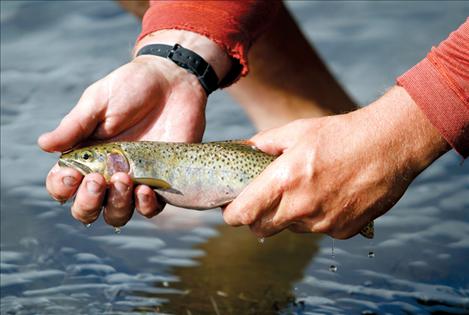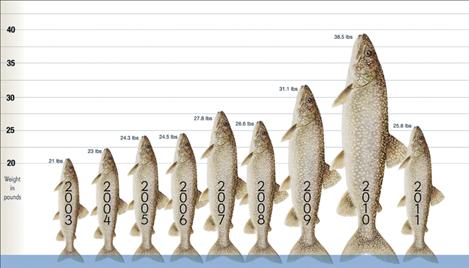Mack Days might be over
Hey savvy news reader! Thanks for choosing local.
You are now reading
2 of 3 free articles.
After a 12-year run, the twice-annual fishing event aimed at reducing Flathead Lake’s lake trout population and increasing the native bull and cutthroat trout populations may be coming to an end.
A statement on the Mack Days website reads, “The prospects for future contests will be determined by the outcome of the environmental impact statement to be completed this spring. If you enjoy Mack Days, it is important to follow and participate in this process because the future of these events is dependent upon the final decision to come out of the EIS. The alternative selected in the EIS will determine whether suppression efforts continue and how much suppression is necessary. Each suppression alternative includes an ordered progression of all possible tools to harvest lake trout. Mack Days is always the first tool, and additional tools would only be employed if and when Mack Days’ harvest does not reach the selected target harvest level. The EIS was only initiated because we determined that Mack Days alone was not sufficient to meet the goals of the co-plan.”
CSKT fisheries biologist Barry Hansen said the contests have grown beautifully over the years, and while there may still be room to grow, spring and fall Mack Days have not measurably changed the lake trout population. The EIS will be a final factor in determining whether or not the contests continue.
“We made a tentative conclusion that it is unlikely that we can grow these contests big enough to harvest enough lake trout to make a difference with these fish,” he said. “The predicament we’re in is that we’re spending hundreds of thousands of dollars every year to increase harvest, but we’re not getting any return we can measure ... if the decision is made that we’re not going to go any farther and deploy anymore of these tools, it doesn’t make sense for us to continue to pursue Mack Days.”
CSKT Fish, Wildlife, Recreation and Conservation division manager Tom McDonald said the EIS contains the highest level of research that is needed for disclosure or public involvement, as it requires the most due process and the most study. As such, he is confident the study will lead the tribes to the right decision.
In terms of the environmental impact statement’s model, Mack Days is set as the model’s status quo, i.e. what is being done by fishery managers right now to reduce lake trout populations — the baseline.
Three alternatives proposing 25, 50 and 73-percent population reductions are being considered.
“Every alternative starts out with Mack Days,” Hansen said. “If we can get to the goal with Mack Days, that’s wonderful. If we learn that we can’t get the goal, then we move on to new tools.”
Hansen said these proposed tools are wide-ranging and include bounties, commercial fishing, gill netting and trap netting. Hansen often hears concerns that gill netting will result in a high amount of binetting (catching fish that are not your target which include, in this case, anything but lake trout) but said the fishery managers have good methods for minimizing this risk.
“When people hear ‘nets,’ they think annihilation,” Hansen said. “That’s not the point. We start with identifying the population size, then model it to determine the harvest necessary to reduce it to a predetermined level. The fears that so many people have of excessive harvest are not justified, in our view. It’s a matter of percent reduction, and it can be done entirely by anglers, but if anglers don’t get there and nets can get there, it’s still the same percentage of fish being removed.”
If, after the EIS is completed and the tribes choose not to pursue any of the alternatives, fishery managers and fishery employees are left with the status quo of Mack Days, which is not working.
“The primary way we know to benefit native fish is by reducing lake trout ... if the decision-makers choose to not move forward with one of these alternatives, then we’re back to the status quo, which is not acceptable, and we would then have to regroup and chart a new direction,” Hansen said. “A new direction, by definition, could not emphasize native fish.”
Hansen said a workshop with a panel of experts will be the last step in completing the EIS and will take place sometime this month.
“We want to do it in a transparent way with some of the best thinkers we know to get to the bottom of it. (The panel) will be our last step in trying to answer all unanswered questions before we finalize the draft EIS,” he said.
McDonald said depending on the outcome of the workshop, there might be additional information that needs to be gathered.
“The intent is to provide the decision-makers with as much data as we can possibly give them,” he said.
The problem, according to Hansen, is that in most big lake or aquatic systems, it is difficult to quantify how many fish are present, and fishery officials did not know how many lake trout were in Flathead Lake until recently. Still, officials recognized the primary cause of bull and cutthroat trout populations taking a dive was predation by lake trout, so something had to be done.
“You can start out with a map that tells you exactly how to get to your destination, or you can just get going and see where you go,” Hansen said.
In 2002, officials chose the later and started Mack Days. Until the last five years, Hansen said officials did not know how abundant lake trout had become. As such, they could not predict what harvest level was needed to bring the population back down to levels beneficial to native trout.
“Our first contest saw a harvest of 900 fish. The last contest, we harvested 36,000. That’s tremendous growth, but you can’t evaluate the benefits of that growth until you know exactly how much you need to get,” he said.
Hansen said the current lake trout population estimate in Flathead Lake is more than one million, and the Mack Days harvest of 70,000 lake trout per year is not bringing the numbers down..
Zimmer Tackle owner Dick “MacMan” Zimmer believes there are two schools of thought on how to manage Flathead Lake. The first is that because bull and cutthroat trout are on the threatened species list, everything should be sacrificed for their benefit. The second is that if something has no economic or recreational value, it shouldn’t take precedent over something that does, so the lake should be managed for lake trout.
His solution is turning the deep-water-dwelling lake trout into a food source through rod-reel commercial fishing.
“Get a whole lot of fisherman out there catching these lake trout and bringing them in,” he said. “It could benefit the tribe; it could create jobs. The tribe has a processing spot for them; I think that would work.”

















